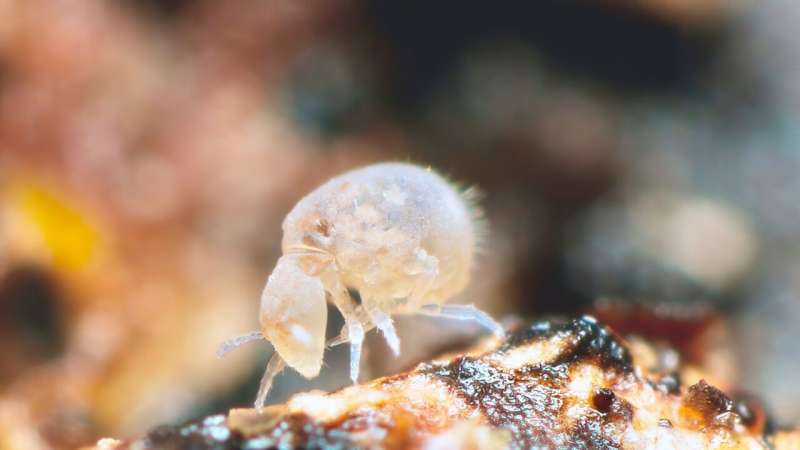This article has been reviewed according to Science X's editorial process and policies. Editors have highlighted the following attributes while ensuring the content's credibility:
fact-checked
peer-reviewed publication
proofread
New comprehensive genome data on soil invertebrates provide insights into their biodiversity

With the "MetaInvert" project, scientists are providing extensive genomic data on 232 species of previously little-studied organisms. They are tiny, enormously diverse, and widespread in the soil: soil invertebrates such as springtails, horn mites, millipedes and nematodes. These animals, which are often only visible under a microscope, fulfill important tasks in the soil ecosystem.
This is why they are increasingly becoming the focus of official measures to preserve biodiversity in the soil. The information contributes significantly to the identification and knowledge of community composition and function and the discovery of evolutionary adaptations to environmental conditions.
But what exactly are the characteristics and abilities of the individual species, which information does their genetic material reveal and how have they developed over the course of evolution?
Their performance is essential for the health of the soil: hordes of small multicellular but invertebrate animals tirelessly decompose organic material, regulate the activity of microorganisms, and promote the circulation of nutrients and the storage of water. In this way, they contribute not least to the production of food for us humans. However, as important as soil animals are—and their significance for the soil is now recognized—they have yet to be comprehensively researched.
This is where the "Metagenomic monitoring of soil communities (MetaInvert)" project comes in, which was developed at the Hessian LOEWE Center for Translational Biodiversity Genomics (TBG) and in which researchers from France, Spain and Sweden are participating alongside TBG and Senckenberg scientists.
In a study published in the journal Communications Biology, they describe their approach and the new genomics methods they use.
"Soil invertebrates are difficult to study due to their microscopic size and incredible diversity. We suspect that there are still hundreds of thousands of undescribed species worldwide. New genomic analysis methods are now providing completely new insights," reports study leader Miklós Bálint, Professor of Functional Environmental Genomics at the Senckenberg Biodiversity and Climate Research Center, Justus Liebig University Giessen, and co-speaker at LOEWE-TBG.
The scientists are primarily focusing on methods of metagenomics and metatranscriptomics.
"While DNA- and RNA-based methods have long been used to support traditional taxonomy and ecological studies in groups of organisms that are difficult to analyze, we use 'shotgun metagenomics' to randomly sequence DNA fragments from a sample. As it can utilize all available genomic information for taxonomic identification, it is an increasingly viable approach to detect the presence of higher organisms with a nucleus, so-called eukaryotes," explains Bálint.
Metatranscriptomics is used to detect genes that are actively transcribed into ribonucleic acids (RNA) as important information and function carriers of a cell and thus control ongoing biological processes. This provides information about the metabolic activity of the members of the soil community and about functional changes in these communities.
According to the study authors, comprehensive genome collections and databases form the "backbone" of these two methods. "With the genomic analysis of the 232 different species in our study, we have now created a large genomic resource to gain insights into the structure, activity and functioning of soil invertebrate communities. In addition, we were able to confirm that theories of genome evolution cannot be generalized across evolutionarily distinct invertebrate groups," says Bálint.
With their results, the authors want to contribute to strengthening the understanding and protection of soil biodiversity. According to the study, the new findings and methods enable more detailed monitoring of both the composition and function of communities. In addition, evolutionary adaptations to changing soil conditions could be traced.
The "MetaInvert-ISO" sub-project, which was also initiated at the LOEWE Center TBG, aims to create a catalogue of standardized analysis methods for assessing soil biodiversity. These methods can be used to record, determine, and utilize reliable taxonomic data for the protection of soil biodiversity in a transparent and practicable manner—independent of legal requirements.
More information: Gemma Collins et al, The MetaInvert soil invertebrate genome resource provides insights into below-ground biodiversity and evolution, Communications Biology (2023). DOI: 10.1038/s42003-023-05621-4
Journal information: Communications Biology
Provided by Senckenberg Gesellschaft für Naturforschung




















